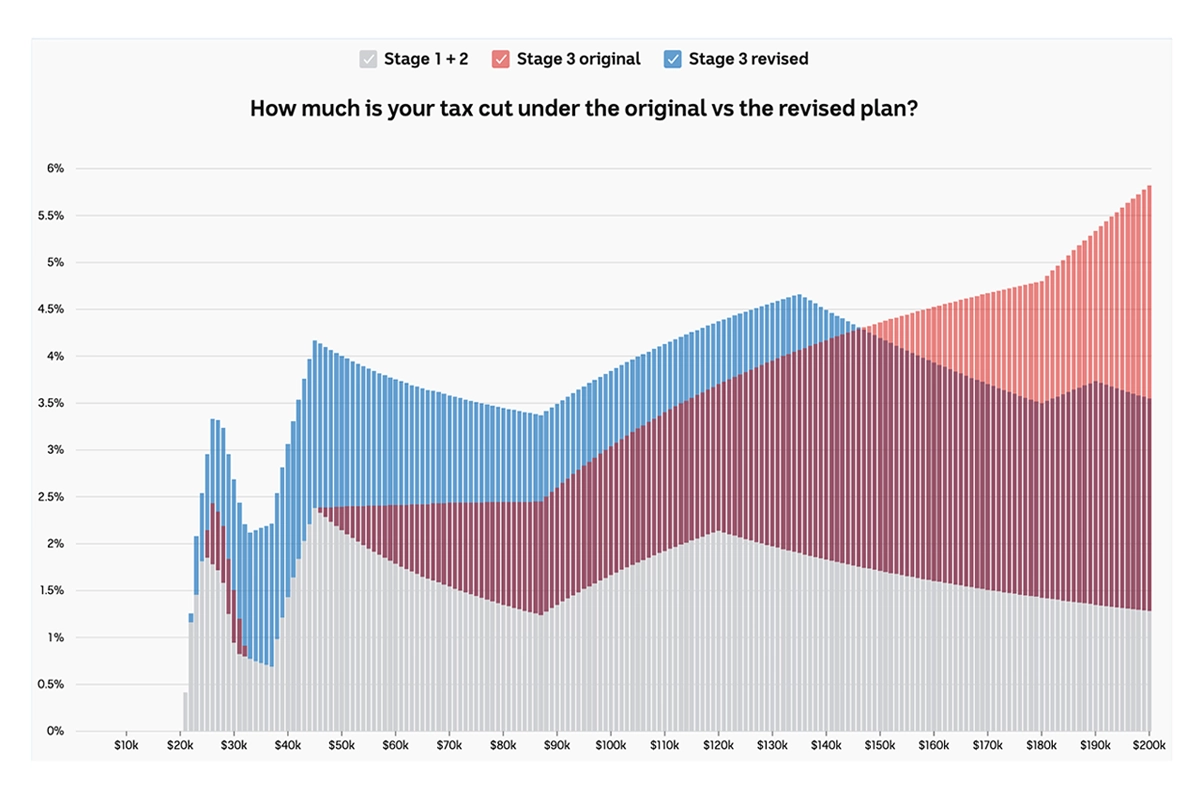Australia’s political stage could be set for a showdown this week as the government introduces its proposal to parliament to overhaul the stage 3 tax cuts. Both parties have claimed that their tax package does a better of job tackling Australia’s cost of living crisis.
The Coalition insists its tax reforms should be appreciated as an entire package, with stages 1 and 2 targeted to low and middle-income earners, and stage 3 designed to “encourage aspiration”.
“If you take away the final part, you’ll unbalance the whole package,” former federal treasurer Peter Costello has warned.
Meanwhile, Labor argues its changes are better aimed at low and middle-income households “disproportionately impacted” by the crisis.
“These new tax cuts are designed to provide bigger tax cuts for middle Australia,” according to the prime minister’s press release announcing the revised plan.
Now, new figures shared exclusively with the ABC reveal the taxable income you need to earn to receive the biggest percentage return across all three stages if the proposed changes are passed into law.
At $135,000 a year, this magic number doesn’t exactly represent “middle Australia”.
“It’s certainly more equitable than the alternative,” says economist Ben Phillips, from ANU’s Centre for Social Research and Methods, which supplied the figures.
“Under the Coalition, really, the higher you went up the income scale, the higher the percentage savings … It’s a package very much tilted in favour of high-income earners.
“It’s true that Labor’s plan still probably tilts things towards more high-income individuals. But it still means that about 90 per cent of people who pay tax will be better off [than under the original plan].”
He points out that the nature of the tax system makes it difficult to return the same percentage to everyone. “If you’re on $20,000, for example, you’re not paying any tax … so it’s hard to give part of that back. That’s just the nature of the tax system.”
The ANU data shows that under the revised plan, the largest percentage return will go to those on a taxable income of $135,000 a year. Those individuals will receive a tax cut of 4.7 per cent of their income, or $6,294, once the tax cuts from all three stages are included.
Under the Coalition’s original plan, the largest percentage return goes to the highest earners, with those on $200,000 set to receive a tax cut of 5.8 per cent of their income, or $11,640.
Under both plans, the smallest percentage return after the full package of cuts is taken into account will go to those on a taxable income of $21,000. On both plans, they receive a return of 0.4 per cent of their income, or $87 – and all of that was already received during stages 1 and 2.
“Clearly, if you had the most progressive tax cuts, you would be giving a higher percentage back to those in the lowest tax brackets. That’s clearly not happening [in either plan],” economist Nicki Hutley says.
“It’s very easy to say [Labor] should have done more for people on median incomes of $60,000 rather than $135,000. But they weren’t starting with a blank slate … and when you take somebody else’s creation, you’re always going to end up with a Frankenstein’s monster.
“It’s not perfect, that’s for sure. Is it awful? No.”
And while neither plan returns the biggest tax cut to those on median incomes, it’s hardly surprising that both parties have focused their public campaigns squarely on “middle Australia”, Ms Hutley adds.
People are “absolutely terrible” at identifying whether they’re rich, poor or truly in the middle. In short, almost all of us think we’re “middle Australia”, she says.
“So, appealing to that group, it’s just clever politics.”
The calculations used in this story assume you are not in receipt of government pensions and allowances, and do not adjust for bracket creep.












